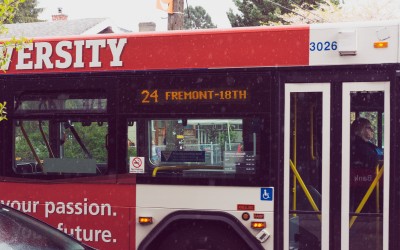Oregon is well into week two of its 'stay at home' order, issued by Governor Kate Brown. To many, it already feels like much more than two weeks as our communities and lives have changed drastically since news of the COVID19 virus entered the mainstream much earlier this year. A considerable amount of anxiety in the air is due to the disruptions of our everyday schedules: Work, school, childcare and socializing all have different meanings now as we've had to adjust our lives around the concept of staying 6 feet (or more) away from neighbors and friends. But for some — especially low-income individuals, service and healthcare workers — life hasn't changed as much.
“Public transit agencies provide essential mobility to millions of Americans. For many people, transit service is the only way to access a doctor, pharmacy, job (including health care jobs), or childcare. This is especially true for many low-income people, communities of color, and people with significant cognitive and physical disabilities that rely on door-to-door paratransit service provided by local transit authorities. It is also true for people who cannot afford to own a car, and seniors, youth, and others who cannot operate a vehicle.” -Transportation for America’s letter to Congress advocating for emergency transit funding in the stimulus bill
Despite countless businesses shuttering their doors for the duration of the COVID19 pandemic, a large portion are operating as normal because they're complying with special conditions in Governor Brown's order or they're deemed "essential." For many Oregonians still working, the need to commute to and from work every day as they did before the pandemic started is still present.
At the same time, a shortage in normal ridership numbers has resulted in service cuts and disruptions for an American industry that's used to providing 9.9 billion rides a year. The adversity transit agencies are facing now could also shake the longterm financial stability and health of public transit services unless we take measures to protect it.

In Oregon alone, most agencies that offer public transit services have made significant adjustments to their operations or ceased them all together:
- TriMet, the largest and most robust provider that covers the Portland Metropolitan area, has gone the route of reducing service. They state that "ridership has dropped due to COVID-19, we will be temporarily reducing service starting April 5. This is a painful-but-necessary adjustment that will help us quickly bounce back when this public health crisis passes." According to TriMet, 29% of riders’ primary trip purpose is recreation, but close behind at 23% is work. Eight percent of trips are for school, and 4% are medical-related. Not only do people in the Portland region depend on public transit to get to the places they have to be, but the continued development of the transit system has created opportunities in the way of job creation, capital investment and the economic expansion of areas near transit corridors.
- Lane Transit District covers Eugene and Springfield, it's reducing service in many areas. With 66% of Lane Transit District riders having a household income of $25,000 or less, low-income riders will be disproportionately affected. As to what ways low-income riders will be affected, the Atlantic says “[a]ccess to just about everything associated with upward mobility and economic progress — jobs, quality food, and goods (at reasonable prices), healthcare, and schooling — relies on the ability to get around in an efficient way, and for an affordable price.”
- Cherriots, Salem's public transit offering, has suspended service after 7 employees tested positive for COVID19. Among its ridership, 58% don’t have access to a car. For the healthcare, grocery store and sanitation workers that comprise the carless 58%, their options are now extremely limited.
- Kayak Public Transit, which operates in eastern Oregon, has shuttered its service completely until at least April 3rd, and will likely continue to remain shut down. Public transit offerings in rural areas are often much less developed than in urban areas — if they exist at all. Kayak Public Transit is unique in that its service range is large — from the Umatilla Indian Reservation to Irrigon, spanning over 60 miles. In rural areas, poverty and concentrations of senior citizens are typically higher than in urban areas; so public transit can be the key to upward economic mobility or simply making it to a medical appointment.
- Amtrak has suspended some of its routes — none in Oregon yet — and it's reducing the number of passengers allowed on each train.
Healthcare workers, grocery store employees, truck drivers, food workers and others are working while the rest self-isolate and social distance. Service cuts can make or break their ability to easily get to where they're needed.
By itself, COVID19 has alleviated much of the day-to-day congestion on public transit most places — as people stay and work at home, or use other methods of transport, like driving for car-owning households. In major cities across the world, transit ridership is down between 30% on the low end, or nearly 90% on the high end. Even with a minimal number of passengers, it's clear that multimodal transit infrastructure enables our communities to function for the benefit of everyone.
There are people in every community across the globe that are essential workers right now, and public transit services must keep running for them to get where they're needed. COVID19 is demonstrating that public transit is pivotal to our communities — and that without it, we'd be a lot worse off.
What 1000 Friends is doing to advance transportation systems
Oregon's land use Goal number 12, transportation, states that "A well designed transportation plan conserves energy while also minimizing adverse social and economic impacts for disadvantaged areas." Accomplishing goal 12 (and many others like energy conservation and economic development) would be impossible to achieve without investing in robust multi-modal transit systems.
Since Oregon's public transportation systems are extremely vulnerable as we battle COVID19, 1000 Friends of Oregon and 247 other organizations called for emergency public funding in the recent national stimulus bill, the CARES act. This request was heard loud and clear: "Congress designated $25 billion in the coronavirus relief bill... to support public transit agencies nationwide, which are struggling with ridership declines and other budget crises."
The funds will allow transit agencies to withstand coronavirus-related difficulties such as declining ridership. Oregon will be receiving $284 million with TriMet alone receiving $196 million in aid, and according to the Federal Transit Administration, “Funding will be provided at a 100 percent federal share, with no local match required, and will be available to support capital, operating, and other expenses generally eligible under those programs to prevent, prepare for, and respond to COVID-19.” Our current situation demonstrates that public transit is vital. After the dust settles, we'll have to continue investing and improving transit systems for the health of our communities.
